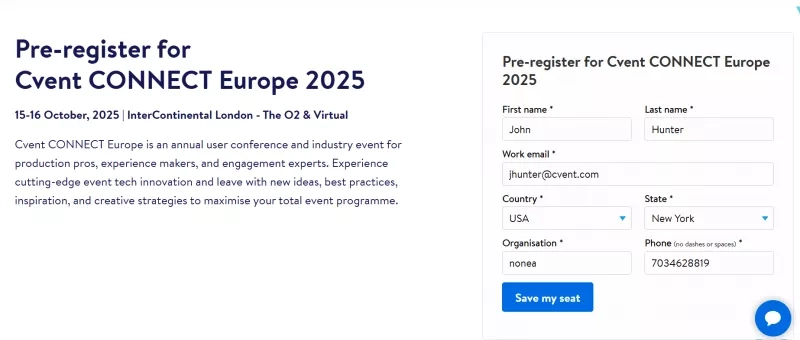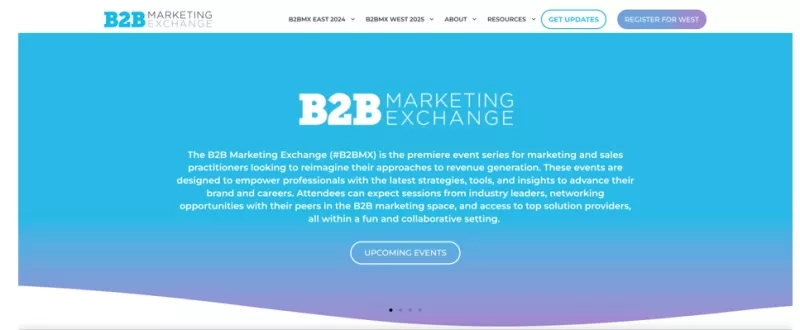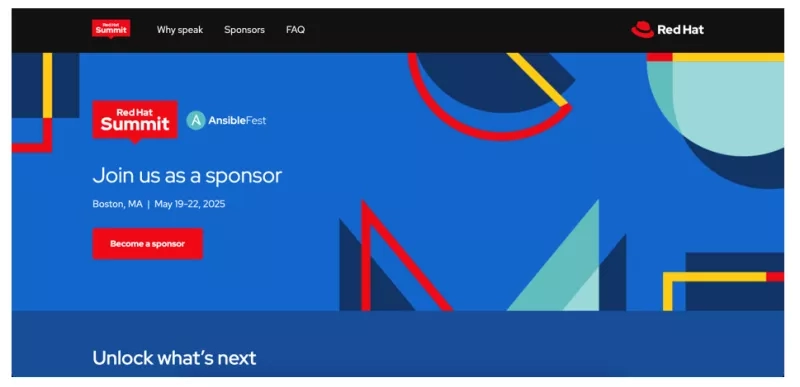For nearly half of large-scale event planners, metrics like total registrations and attendance are the ultimate benchmarks for success. And what’s the central player driving those numbers? Your event landing page.
If you’re serious about boosting registrations and running a successful event, knowing how to design a landing page that grabs attention and compels action is absolutely essential.
Event landing page basics
Think of your event landing page as the warm handshake at the door—it’s your digital welcome mat. Unlike general web pages that juggle multiple roles, this page has one singular mission: to convert visitors into enthusiastic attendees.
It’s like having a conversation with someone curious about your event. Every element—whether the headline, the visuals, or that all-important "Register Now" button—should nudge them closer to saying, “I’m in!”
The importance of event landing pages
A great landing page is the backbone of your event marketing strategy. Here’s why:
- A central hub: Whether they’re clicking through an email, a social media post, or an ad, this is where your potential participants will land to learn about your event.
- They build trust: A polished, professional page immediately signals credibility. People are more likely to commit to an event when it looks legit—especially if the ticket price is steep.
- Your 24/7 sales rep: Your landing page works around the clock to inform, persuade, and convert. It answers questions, resolves doubts, and provides a seamless path to registration.
Types of event landing pages
Not all landing pages are created equal. Depending on where you are in your event planning cycle, you’ll lean toward one of two types:
1. Registration-focused pages
These are your closers. Their entire purpose is to secure sign-ups—whether for a free webinar or a high-ticket conference. Everything on the page, from the catchy descriptions to the strategically placed CTAs, is to make people sign up.
2. Lead generation pages
Sometimes, it’s too early to push for registrations. That’s where lead gen pages shine. These are perfect for collecting emails and building interest before tickets even go on sale. By offering sneak peeks, early-bird perks, or exclusive content, you can build a list of engaged prospects to nurture into attendees later on.
8 things you need to include on an event landing page
There are some universal elements that all event landing pages should include. Some of these are:
1. About the company and brand
Your audience wants to know who you are. Be open about your organization—share your story and the reason for the event. A great brand narrative helps build trust and connect with potential attendees on a human level.
2. Event details
Describe your event in a way that captures its excitement and practicality. What’s it all about? Is it a tech summit or an art workshop—explain what attendees will get out of it. Don’t forget to include the agenda so they can see the flow of the day and what to expect.
3. Logistics
Make sure your event’s date, time, and location are impossible to miss. If it’s in person, go the extra mile by providing:
- Venue details with clear directions.
- Parking tips or public transit options.
- Nearby accommodations for out-of-town guests.
- Any setup details attendees should know.
For virtual events, include clear instructions on how to join the platform.
4. Speaker highlights
Shine a light on their expertise with bios that outline their accomplishments and what they will be covering. If your lineup isn’t finalized yet, consider showcasing past speakers to give an idea of the caliber of presenters your event features.
5. Sponsor recognition
Sponsors play a key role in many events, so give them a nod. Dedicate a section to feature their logos and support while keeping the focus on registration. This fulfills sponsor commitments and reinforces the event’s credibility.
6. A clear and compelling call-to-action (CTA)
The CTA is the bridge between interest and action. Use action words like “Save Now” or “Buy Now.” While you can have multiple CTAs scattered across the page, ensure they all lead to the same registration process.
7. Simplified registration process
Friction is the enemy of conversions. Keep your event registration form short and sweet by only asking for the essentials. Smart forms that adapt to user input can make it even easier for your attendees to sign up.
8. Social sharing
Let your audience promote for you. Add share buttons for LinkedIn, Facebook, and Twitter so registrants can share with their networks. This kind of word of mouth often reaches people who are just as interested in attending.
Top 10 tips for creating an event landing page
1. Start with a plan
Don’t dive in without a game plan. Ask yourself: What’s the main purpose of your landing page? Whether selling tickets, collecting leads or simply sparking interest, having a clear goal in mind will keep your efforts focused.
When you map things out in advance—like which visuals to use or what kind of CTA to include—you save both time and energy. A well-thought-out page isn’t just visually appealing; it delivers actual results.
2. Set a clear conversion goal
Every event landing page falls into one of two categories:
- Registration-Focused: Designed to get those tickets sold.
- Lead Generation: Perfect for collecting early interest and growing your contact list.
Pin down what success looks like for you, be it a certain number of ticket sales or a robust list of leads. When you know exactly what you’re aiming for, every design and content decision becomes much easier.
3. Know your audience
Here’s the thing: Not all audiences are the same. Are you speaking to business professionals gearing up for a conference? Or maybe creatives looking for an art fair?
Tailor everything, your visuals, tone, even the color palette, to match their expectations. If your event caters to multiple groups, consider segmenting your audience and crafting messaging that resonates with each one. People connect with what feels personal, so ditch the generic and go for tailored.
4. Write copy that sells
Good copy doesn’t just inform; it excites. Use your words to tell a story about your event:
- Who: Will there be industry-leading speakers, inspiring performers, or big-name sponsors?
- What: Is it a casual workshop, a professional summit, or a gala night?
- Why: What’s in it for the attendees? Education, networking, fun? Spell it out.
- When & Where: Be specific. Add a countdown timer for urgency if appropriate.
- How: Simplify the registration process so it’s a no-brainer.
The more vividly you can describe the event experience, the better your chances of converting casual browsers into confirmed attendees.
5. Use CTAs like a pro
Your CTA should be bold and clear and must be impossible to miss. Phrases like “Join Us Now” or “Reserve Your Spot” work wonders for creating urgency.
Just don’t go overboard—too many CTAs can dilute your message. Stick to one primary action and, if necessary, a secondary option like “Share With Friends” to boost engagement after registration.
6. Design for impact
Your landing page should grab attention the second it loads—but it shouldn’t overwhelm readers. Start with these design must-haves:
- Hero Image: A stunning, high-quality image sets the tone instantly. Pair it with a clear CTA for maximum impact.
- Video Content: A short teaser showcasing highlights or speakers creates excitement.
- Social Proof: Testimonials, reviews, or past event snapshots help establish credibility and build trust.
And don’t forget consistency. The page should reflect your brand’s style, from colors to fonts, so it feels cohesive and professional.
7. Make it responsive
Most of your audience will likely check out your page on their phones, so ensure it’s mobile-responsive. Test everything—buttons, text size, layouts—to ensure it looks great and works seamlessly on smaller screens.
8. Master SEO
Your landing page isn’t just a destination—it’s a magnet for organic traffic. Use relevant keywords strategically in your headlines and copy to boost your page’s visibility in search engines. The higher your page ranks, the more potential attendees you’ll attract.
9. Use basic forms
No one likes a long form. Keep it short by only asking for what’s necessary. If possible, use smart forms that adapt based on the user’s answers. A smooth registration process equals fewer drop-offs and more sign-ups.
10. Create personalized experiences
Finally, bring all of this together with an event registration technology that is as responsive, intuitive, and flexible as the events you plan. Make your page pop with different elements like a countdown timer or subtle animations, and build a personalized registration flow. Be careful not to overdo it—clean and functional beats flashy any day.
Event landing page examples
Cvent CONNECT
Cvent CONNECT’s landing page is a masterclass in clarity and impact. Its bold headline grabs attention right away, while high-quality visuals from previous events set the tone for what's to come.
The CTAs are prominent and action-driven, guiding visitors toward registration. Balancing crisp event details with engaging social proof like testimonials and past highlights creates a user experience that feels both informative and inviting.
B2B Marketing Exchange Experience
The B2B Marketing Exchange landing page is all about efficiency and engagement.
Its layout and intuitive navigation make it easy for visitors to find what they need. Eye-catching animations guide users through sections, while testimonials, social media feeds, and sponsor logos reinforce credibility. Detailed speaker profiles add depth, giving attendees a clear sense of the event’s value.
Red Hat Summit
The Red Hat Summit landing page shines with its sleek, modern aesthetic. Clever use of brand colors and generous white space draws attention to the most important details, like dates and CTAs.
The hero section hooks visitors with vibrant visuals and bold contrasts, while key statistics displayed prominently below build trust at a glance. The page’s minimalist design and well-organized sections make navigation effortless, ensuring sponsors, speakers, and attendees can easily find what they need. Multiple CTAs scattered strategically throughout encourage quick action.
Frequently asked questions
What is usually included on a landing page?
An event landing page typically covers all the essentials:
- Event details like date, time, and location.
- A value proposition that explains why attendees should join.
- Speaker bios, agenda highlights, and any notable features.
- A simple registration form.
- Social proof, such as testimonials or stats from previous events.
How is a landing page different from an event website?
A landing page is highly focused and designed for one purpose—getting visitors to take a specific action, like registering for an event. Unlike an event website, which may have multiple pages and goals, a landing page eliminates distractions to guide users toward a single outcome.
How much does it cost to create a landing page?
Costs can vary widely depending on your approach. Using platforms like Cvent provides cost-effective solutions with pre-designed templates, while custom-built pages may offer more flexibility but come with higher expenses.
How can I create an event landing page?
You have options! Event management tools, website builders, or custom development can all work, depending on your needs. The key is to choose a solution that aligns with your technical skills and event goals while ensuring it has all the features necessary for success.
Make your event landing page work for you
Your event landing page is the essential link between curiosity and commitment. Whether you’re hosting a bustling conference, a cozy workshop, or an online summit, putting time into crafting a well-optimized page will directly impact your registrations and attendee engagement.
By prioritizing clarity, creating engaging content, and focusing on seamless conversions, your landing page can do the heavy lifting—leaving you more time to plan other aspects of your event.
Looking for tools to simplify the process?
Cvent’s event registration free trial can help get you started designing landing pages that not only look great but also drive results. Explore how they can take your event marketing to the next level.














